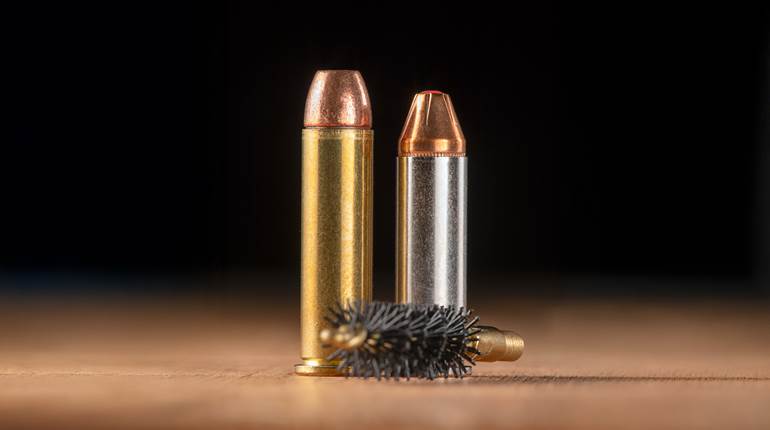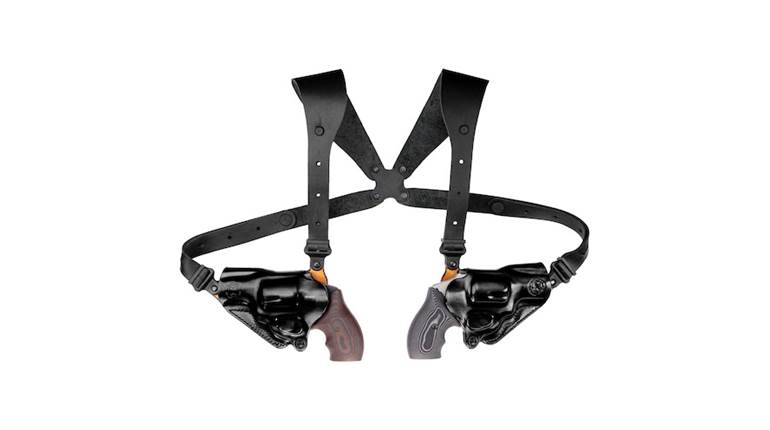
This article, "Bill Ruger's Flat Top .44: 50 Years Later," appeared originally in the June 2006 issue of American Rifleman. To subscribe to the magazine, visit the NRA membership page and select American Rifleman as your member magazine.
In his letter to American Rifleman technical staffer M.D. “Bud” Waite, dated Sept. 7, 1956, William B. Ruger, Sr., discoursed at length on a favorite subject—his latest gun. The firearm in question was the brand-new Ruger Blackhawk chambered for the equally new .44 Remington Magnum cartridge. It was a milestone gun in the ongoing history of the company.
On the 50th anniversary of its introduction, Ruger now offers for sale an updated version of the gun collectors call the “Flat Top.” The design of this special-issue revolver, which will be sold only during 2006, replicates the style and most dimensions of the 50-year-old classic. Intended to be as much a working revolver as a keepsake, its action and other functional details are consistent with 50 years of progress and development. Over the years, new models have come and gone, but the original Flat Top .44 has an especially intriguing history.
In the early 1950s, Bill Ruger was struggling to keep his quality and sales as high as his expectations. His fledgling company had started with a roar in 1949 on the basis of a single gun product—the Standard Auto. The rugged .22 semi-automatic pistol had an immense appeal to all kinds of shooters. It was accurate, reliable and above all, inexpensive. I can personally recall the ads in these pages and the $37.50 price tag. Riding the success of the auto, Ruger then came out with the Single Six, another .22 rimfire that was styled after the guns used by Western heroes of TV and the movies. Both were solid products that sold well, and they essentially established the company. Despite the success of his rimfires, Ruger wanted to go further with centerfire arms.
At that point in time, Westerns were very popular, and many people were looking for a good used Peacemaker—or two. Ruger sensed the depth of that market and, in 1955, introduced the Blackhawk revolver in .357 Remington Magnum. It was a radically updated single-action sixgun with the lines and balance of the Colt, but also with adjustable sights, coil springs and modern steel throughout.
After some consideration, Ruger followed with a host of other calibers in subsequent years. Once again, the guns were a resounding success, putting Sturm, Ruger & Co. firmly in the center-fire handgun business. Although there were growing pains and lessons learned, the single-action-style revolver is fairly easy to make and very durable. The Blackhawk .357 has stood the test of time, so much so that the company offered a special 50th-Year commemorative in 2005.

Aside from the obvious gold-filled commemorative roll mark atop the barrel of today’s “Flat Top” Blackhawk (bottom), little else differentiates it from one of the first original guns made in 1956 (top & above). The new revolver is a blend of Ruger’s most modern features, married to pure 1950’s styling.
That brings us to the point in ’55 when Ruger was sitting in his office, considering new products. A friend stopped by with five fired revolver cartridge cases picked up from a scrap heap in Bridgeport, Conn. The Remington-brand cases had an unfamiliar headstamp: “.44 Magnum.” The mystery rounds were identical to the existing .44 Spl., except for length. Hurried phone calls to associates at Remington produced only denials that such a round as a “.44 Magnum” even existed. It was well known, however, that a certain cowboy out in Idaho had been badgering the ammo companies to build such a thing for years. Almost immediately, Bill Ruger began designing a Blackhawk revolver for the new cartridge.
The development of the .44 Blackhawk was the subject of the letter, still in American Rifleman’s files, sent to Bud Waite as he prepared to write up the new gun. Ruger had designed a revolver without a round of ammunition to fire in it. But obviously he could not make them for sale until he had conducted proof testing. Eventually, he was able to wheedle a paper bag full of loaded .44 Magnums out of a friendly Remington executive and complete the development of his gun. He didn’t beat the other maker to the punch, but he was so close on its heels that he almost did.
The original .44 Blackhawk was very well received, probably as well or better than the previous year’s .357 Blackhawk. The new gun had several dimensional changes to accept the .44 Mag. round, but it was generally the same gun as the .357.
Since all of this transpired, there have been many changes to the Blackhawk revolver. The biggest one was made in 1973, when the gun grew larger, got new lockwork and a new name—the New Model Blackhawk. Original .44 Blackhawks evolved into Super Blackhawks in 1959. Shooters complained about the lack of weight, the short grip and the nasty recoil of the originals, so Ruger complied with a longer grip frame, heavy unfluted cylinder and longer heavy barrel. The company also changed the contour of the main frame in the top-strap area. The change gave greater weight and strength to the frame via pronounced ears that shield the rear sight from handling damage.

The new Ruger “Flat Top” Blackhawk (below) is a near-identical copy of serial No. 14 (above) that was tested by American Rifleman staffer M.D. “Bud” Waite.
It was collectors who first gave the early center-fire Rugers the nickname “Flat Top.” It was never an official designation and was probably never used until there was an alternative frame style. That happened relatively early in the life of the Blackhawk revolvers. By 1959, the .44 Mag. Blackhawks all became Super Blackhawks, and the Flat Top frames were gone in all chamberings by 1962.
In those early days of Ruger center-fire production, lots of outdoor types bought .44 Blackhawks. I know of several who still have their guns but loudly lament the fact that they shortened the factory barrels to 4 5⁄8" for greater handling ease. One of those guns made several jumps in the leg pocket of a smoke jumper’s coveralls. An original barrel, necessary to right the wrong, is a hard thing to find. Mint-condition original Flat Top .44s that sold for $98 in 1956 are now worth more $1,000.
To fill the demand for a Blackhawk in the original style and mark its half-century milestone, Ruger has come out with the two 50th Anniversary Models. Ruger only recently downsized and updated its fixed-sight Vaquero pistols. In doing so, the firm developed the ability to make a somewhat trimmer single-action than was its norm for many years. I suspect that these 50th Anniversary Models may be a continuation of that trend.
By any standard, these are remarkably appealing guns. As much as could be done to make them like the Eisenhower-era revolvers was done. The grips, for example, are a close reproduction of the molded and finely checkered hard-rubber grips used on the originals. I don’t believe these are really made of rubber, but they closely simulate the Peacemaker style. On the 50th Anniversary Models, they wear Ruger’s own distinctive black eagle medallion. I also noted that the Flat Top frame has a recess to accept a fully adjustable rear sight marked (in script) “Micro.” Original guns had just such a sight. The grip frame itself is of the original XR-3 contours that many shooters like so much.

Fifty years is a long time to make a gun, and Ruger did not neglect improvements. That’s why both of the 50th-year revolvers have the most advanced single-action lockwork ever put on a production revolver. In effect, the new action on these guns takes the 1973 internal improvements a step further. Once you got used to them, original-style Colt and Remington single-actions were not difficult to understand. You had to accept the necessity of carrying such a gun with the hammer down over an empty chamber. This meant a tricky “load one, skip one, load four” procedure with the gun at half cock. With Rugers made after ’73, this was no longer necessary because of the improved transfer-bar mechanism.
The latest guns are even better because of a device called a reverse-indexing pawl. This is a means by which the shooter easily indexes the cylinder for loading and unloading. Just a small amount of counterclockwise movement against the normal turning of the cylinder puts it in perfect alignment for a quick push of the ejector rod or insertion of a new round.
I fired the two new guns extensively and found them to be accurate and reliable. It’s also interesting to see that Ruger used a 1:20" twist rate in the .44 barrel, but 1:16" in the .357. It is a matter I would have liked to pursue with a greater variety of ammunition, but I believe the .357 has the potential of being an exceptional revolver in the accuracy department. The .44 Mag. is no slouch and is as accurate as any Ruger .44 I have ever used.

Both guns are rather light, but they are not as light as the originals. This time, the factory chose to use a steel grip frame rather than an aluminum one as on the original guns. For that reason, the recoil is not as nasty as the original’s.
Ruger has chosen to build these revolvers for a year only. They come in a special, vivid-red plastic box, accompanied by the normal accessories and a special commemorative booklet for each model. Well written by Ruger President Steve Sanetti, the booklet is exceptionally helpful. Each explains the individual model’s place in the history of the company. I got a chuckle when I read how Colt had virtually abandoned making single-action revolvers in the late ’40s, only to see Ruger introduce the Blackhawk in 1955. Colt re-introduced the Single Action revolver in 1956.
It will be interesting to see how the buying public treats these special anniversary models. I have the feeling that both may be regarded as guns that are put away unfired—treasured mementos of another time. I really hope this does not happen, since both guns are fine shooters and deserve to be used as well as treasured.

Reading back across my copy of Ruger’s letter to Waite about the trials and tribulations of bringing a gun to market back in ’56, I am struck by the clear sense of vision and purpose that Ruger certainly had. At this point, Sturm, Ruger & Co. was still thought of as a maker of nice little rimfires. As he wrote that letter, he had just introduced a very nice .357 Mag. that was doing well. But he was capable of grasping the importance of that handful of fired brass that was dumped on his desk. He was also decisive, changing direction in a matter of minutes and going off on the development and production of a completely new model. It was necessary, and he knew it instantly.
The first Ruger .44 was in fact a resounding success, fully justifying Bill Ruger’s words: “I am, personally, very pleased with the result.”




































